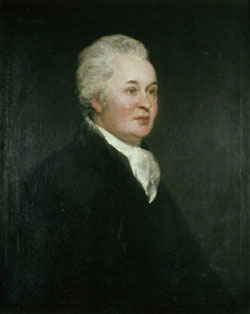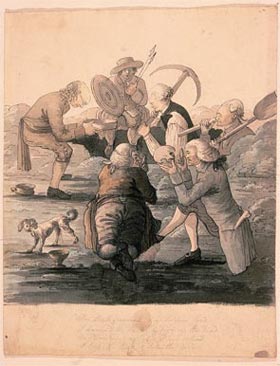 James
Douglas, (7 January 1753 – 11 November 1819), clerk, Vicar of Kenton, Suffolk, Rector of
Middleton, Sussex, Chaplain to HRH the Prince Regent and Curate of Preston,
near Brighton. Born in London, he was the third and youngest son of John Douglas
(d. 1762) of St. George's, Hanover Square, an innkeeper of the Hercules
Pillars(1) in Hyde Park Road, and Mary Gardiner (d. 1766). James
Douglas, (7 January 1753 – 11 November 1819), clerk, Vicar of Kenton, Suffolk, Rector of
Middleton, Sussex, Chaplain to HRH the Prince Regent and Curate of Preston,
near Brighton. Born in London, he was the third and youngest son of John Douglas
(d. 1762) of St. George's, Hanover Square, an innkeeper of the Hercules
Pillars(1) in Hyde Park Road, and Mary Gardiner (d. 1766).
Of nine siblings only the three boys survived. After the deaths of
his parents he was brought up by his elder brother
William (1745–1810) in
Manchester, where James belatedly attended Manchester grammar school.
The chronology of Douglas's next few years remains obscure, but he was
employed by his brother William, a cloth merchant, and was eventually sent
overseas as his agent in Italy—only to be dismissed and cut off when he
misappropriated some of the funds with which he had been entrusted.
Desperate to support himself, he entered the Austrian Army as a cadet, and,
at Vienna became acquainted with Baron Trenk. Being sent by Prince John of
Liechtenstein to purchase horses(1) in England for Turkey,
he jocularly observed that he thought his head grinning on the gates of
Constantinople would not be a very becoming sight. He did not therefore
return and exchanged the Austrian Army for the British service.
He
certainly toured the Low Countries in 1773 and he may have briefly attended
a military college in Flanders. In 1777 and 1778, however, he was a student
at Peterhouse, Cambridge, though he did not graduate. In 1779 he accepted a
commission as a lieutenant in the Leicester militia, served on the staff of
Colonel Hugh Debbieg, and was put to work as an engineer fortifying Chatham
Lines (1758–1807), on the Medway, adjacent to Rochester in Kent.
James
Douglas was a soldier who first came across barrow clusters when, as a
military engineer, he helped to remodel the defensive earthworks protecting
the Medway and Chatham Docks in Kent.
 |
James Douglas (1753-1819)
The Barrow Diggers, c.1787
Pen
and ink wash on paper.
This humerous drawing is one of the
earliest depictions of barrow-digging known, and is unusual in
concentrating on the diggers rather than the landscape. The
clergyman with the pickaxe in the trench is probably a self
portrait. Douglas was a fellow of the Society of Antiquaries and his
Nenia Britannica, or a sepulchral history 0f Great Britain contains
the earliest known illustrations of British field archaeology.
Illustrated in colour as frontispiece to AR |
Many barrows were disturbed during
these operations, and from them Douglas amassed a collection of Saxon
relics, which he carefully recorded. He produced perhaps the earliest ground
plan of an excavated tumulus known to English archaeology.
On 6
January 1780 Douglas married Margaret (1760–1820), daughter of John
Oldershaw of Rochester, a surgeon. In 1781 Douglas published a two-volume
translation from the French of J. A. H. Guibert entitled A General Essay on
Military Tactics ‘by an Officer’. The next year he likewise issued and
illustrated an anonymous Travelling Anecdotes, through Various Parts of
Europe (1782), which was successful enough to require London editions in
1785 and 1786, with a Dublin one following in 1787—by which time the
author's name had been added. Written primarily at Cambridge during his
student years, and in an unconventional manner reminiscent of Tristram
Shandy, the Anecdotes (some of them military) recalled the author's earlier
experiences at Vienna and in the Low Countries, where, at Tongres
especially, his antiquarian interests had been aroused.
At one point
in his youth Douglas had been associated with the noted collector and
antiquary Sir Ashton Lever, even assisting him in stuffing some of the birds
later displayed in Lever's Leicester Square museum (1774–88). In 1783,
sponsored by Lever and others, Douglas was elected a fellow of the Society
of Antiquaries, a learned society that meant more to him than any other. He
was ordained the same year. Though Douglas would later exemplify his
clerical devotion with Twelve Discourses on the Influence of the Christian
Religion on Civil Society (1792), he identified himself on the title-page
first as a fellow of the Society of Antiquaries and only second as chaplain
in ordinary to the prince of Wales.
Between 1785 and 1793 Douglas
wrote the two works for which he is most often remembered. The first of
these, A Dissertation on the Antiquity of the Earth (1785), had been
presented originally on 12 May as a paper before the Royal Society. Without
having been refereed, the paper was then withdrawn (and retitled) for
publication as an independent work. In its final form Douglas's
Dissertation, illustrated with aquatints by himself, consisted of three
inductive ‘cases’ and a lengthy appendix commenting on previous geological
theories. The first case comprised a group of relics from a barrow on
Chatham Hill that Douglas had had opened in 1779; the second, another group
from a barrow at Kingston opened by Bryan Fawsett in 1771; and the third,
fossils from the Isle of Sheppey collected by himself and Sir Joseph Banks.
Though Douglas, like most men of his time, believed in the reality of the
Noachian flood, the Sheppey fossils and others demonstrated independently of
Genesis—for him, at least—that there had been an inhabited antediluvian
world full of animals (and probably human beings) subsequently destroyed by
just such a global catastrophe as the Flood.
At the time Douglas was
writing, the vast duration of geological time was entirely unrecognized. His
final remarks nevertheless emphasized four important points: the fossilized
animals and plants, though tropical, had lived where they were found; the
climate then was much warmer than in his day; a forty-day flood (as in
Genesis) would not have sufficed to transport animal remains from afar (as
other theorists had contended); and the earth had some unknown power within
it to fossilize organic remains. These conclusions, though not unique to
himself, were of far-reaching intellectual significance.
Douglas's
second major work, and no less important than the Dissertation, was Nenia
Britannica, or, A sepulchural history of Great Britain from the earliest
period to its general conversion to Christianity, which was published in
twelve parts from May 1786 to 1793 and as a book in 1793, again with his own
illustrations. Consisting primarily of archaeological reports, the book (nenia
meaning ‘dirge’) aspired to be a general history of the funerary customs of
ancient Britons, whether Celtic, Anglo-Saxon, Roman, or Danish. Douglas
therefore described excavations by himself of barrows at Chatham Lines
(1779–93) and of graves at Ashford, Kent (1771 and 1783), and in
Leicestershire (undated). Other portions of the book discuss some early
barrow diggings on Chartham Downs, Kent, near Ashford, by Cromwell Mortimer
(an early founder of the Society of Antiquaries) in 1730; miscellaneous
antiquities; the opening of ditched barrows in Greenwich Park; and the
contents of numerous ‘small barrows’ recognized for the first time as being
Anglo-Saxon. Douglas also describes Roman graves in Britain and at Tongres
in Flanders. Finally, there is a lengthy analysis of Stonehenge. His
interest in funerary monuments may have been caused by his many
bereavements, having lost both parents, his six sisters and two brothers.
Douglas's personal copy of Nenia Britannica in the British Library includes
his original drawings, twenty-six extra illustrations, and some manuscript
additions. Many of the relics he described are now in the Ashmolean Museum
at Oxford. He also published several other papers on antiquarian subjects,
of which ‘Two dissertations on the brass [in fact, bronze] instruments
called Celts’ (1785) is the most important.
Finally, Douglas tried
his hand at novels, of which there were three, though none were of permanent
literary value: Fashionable Infidelity (3 vols., 1790; no surviving copy);
The Maid of Kent (3 vols., 1790); and The History of Julia d'Haumont (2
vols., 1797). In addition to the illustrations for his own works, he painted
some excellent portraits of his friends, both in oils and miniature, and
drew a caricature of his fellow antiquary Francis Grose, at which Grose
reportedly took offence; an engraving was published anonymously. He also
contributed an engraving of Coston church to John Nichols's History and
Antiquities of the County of Leicester.
He later took holy orders.
Douglas's wandering ministry brought him livings successively in
Chiddingfold, Surrey, in 1785; Litchborough, Northamptonshire, in 1787;
Middleton, Sussex, in 1799; and Kenton, Suffolk, in 1803. After 1809 he
lived in several further locations in Sussex, and he died of a chill at
Vicarage House, Preston, near Brighton, Sussex, on 11 November 1819. He was
buried in the local churchyard three days later. He was survived by his
wife, who died the next year, and by three sons and one daughter.
Father: John Douglas
Mother: Mary Gardner
Marriage 1 Margaret Oldershaw,
Children:
- Unknown Douglas
- Edward Douglas
- Margaret Martha Whiteman Douglas c1782 -
- James Bruce Douglas, 1785 - 1786
- Alexander Douglas, 1785 -
- James Edward Moreton Douglas, 1794 -
- Richard William Glode Douglas
Unknown married (1) lord Daphne and (2) Marquis of
Londonderry
James, JP, MD, married Mary Young Morgan. He served
in the Prince's Regiment. They has a son, Canon James John Douglas.
Note:
1. We may assume that James' knowledge of horses
is, in some way, connected with his father business.
Where Apsley House now stands, if we may accept the statement of
Charles Knight, was the tavern called the "Hercules' Pillars," "the same at
which the redoubted Squire Western, with his clerical satellite, is
represented as taking up his abode on his arrival in London, and conveying
the fair Sophia." The sign of the "Hercules' Pillars" was given to the
tavern probably as marking, at that time, the extreme "west-end" of London.
Its name is recorded by Wycherley, in his Plain Dealer, and is said to have
been a haunt of the Marquis of Granby, and of other members of the titled
classes. The character of the house in Fielding's time may be gathered from
the following quotation from "Tom Jones," touching Squire Western's arrival
in London:—"The squire sat down to regale himself over a bottle of wine,
with his parson and the landlord of the 'Hercules' Pillars,' who, as the
squire said, would make an excellent third man, and would inform them of the
news of the town; for, to be sure, says he, he knows a good deal, since the
horses of many of 'the quality' stand at his door."
Mr. J. H. Jesse
tells us that the tavern in question stood between Apsley House and Hamilton
Place, and that, on account of its situation, it was much frequented by
gentlemen from the West of England. Wherever may have been the exact spot on
which the house stood, it seems at best to have been a comfortable but low
inn on the outskirts of the town, where gentlemen's horses and grooms were
put up, and farmers and graziers resorted.
|
|


